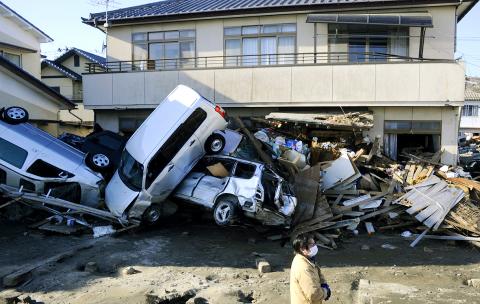|
ˇ@
Japan still leads the way in disaster preparedness
AFP, TOKYO
ˇ@

A man stands outside his destroyed house after the tsunami hit in
Iwaki, Fukushima Prefecture, Japan, yesterday.
Photo: EPA
In catastrophe-prone Japan, regularly shaken by earthquakes, dotted with more
than 100 volcanoes and swept by typhoons, living with the threat of natural
disasters is just a part of life.
The memory of past calamities has made Japanˇ¦s 128 million people and their
government better prepared for disaster than most other countries.
Even so, most people realize there are limits to preparing for a mega-disaster
such as the massive quake and tsunami that hit on Friday.
However, zealous safety preparations, regular drills and, crucially, the
countryˇ¦s wealth, which allows for expensive quake-proofing of buildings and
infrastructure, have saved thousands of lives in recent decades, experts say.
ˇ§If there is any place in the world ready for a disaster of the scale and scope
of this historic calamity, it is Japan,ˇ¨ said Stacey White, a senior research
consultant at the Centre for Strategic and International Studies.
Toshitaka Katada, a professor at Gunma Universityˇ¦s Disaster Social Engineering
Laboratory, said Japan had proved that lives could be saved.
ˇ§In the past Japan used to be just like todayˇ¦s Southeast Asian countries when
disaster struck,ˇ¨ he said. ˇ§Thousands of people died every year until 50 years
ago.ˇ¨
Since a typhoon killed more than 5,000 people in 1959 death tolls have fallen
into the hundreds or dozens during most disasters ˇX with the exception of the
1995 Kobe earthquake, which killed more then 6,400 people ˇX he said.
ˇ§This is because the government has made protecting its citizens from disaster a
state responsibility,ˇ¨ he said.
In part this has been achieved by building infrastructure such as river dykes
and retaining walls against floods and landslides.
Most Japanese know the drill and keep a backpack near the door, filled with
bottled water, dried or canned food, a first-aid kit, cash, clothes, a radio, a
torch and lots of spare batteries.
People know they should try to hide under a solid table to guard against falling
objects, to quickly turn off the gas mains, and to keep a door ajar lest a
tremor jams it shut and traps them inside a crumbling house.
Common advice is to keep a spare pair of shoes under the bed, and a bicycle
outside, to navigate rooms and roads littered with broken glass and debris.
Many people subscribe to mobile phone quake alerts, schoolchildren have padded
and flame retardant headwear under their desks, and people can prepare for the
real thing in a high-tech earthquake simulator.
Earthquake kits are sold in department stores and people are urged to supplement
them with key personal items ˇX spare glasses and special medication, or extra
diapers and baby food.
Families are told to work out emergency meeting spots and times for the very
worst cases ˇX for example, if many buildings have collapsed and are on fire, and
mobile phone systems have broken down.
Many more lives are saved when disaster strikes in Japan than in other nations
simply because it is a wealthier country.
Nuclear power plants and bullet trains are designed to automatically shut down
when the earth rumbles, and many buildings have been quake-proofed with steel
and reinforced concrete at great cost in recent decades.
ˇ§Japan has the most advanced early warning system in the world,ˇ¨ said Hiroshi
Inoue of the National Research Institute for Earth Science and Disaster
Prevention. ˇ§But itˇ¦s not perfect, especially for those near the epicenter.ˇ¨
Good governance and the rule of law are also seen as crucial.
A school or hospital is less likely to collapse if it is well built and has not
been weakened because a corrupt official has used shoddy materials to siphon off
money, as has happened in other countries in the past.
Many lessons were learned from the Kobe quake, where the human and economic toll
highlighted a lack of preparedness and served as a wake-up call for authorities
to better ready citizens for quakes in a country hit by an average of 1,500
tremors every year.
ˇ§As a result, Japanˇ¦s quake-proofing technology has developed dramatically.
Japan is undoubtedly leading the world in that technology,ˇ¨ Nomura Research
analyst Satoru Saito said.
ˇ@
ˇ@
|
![]()
![]()
![]()